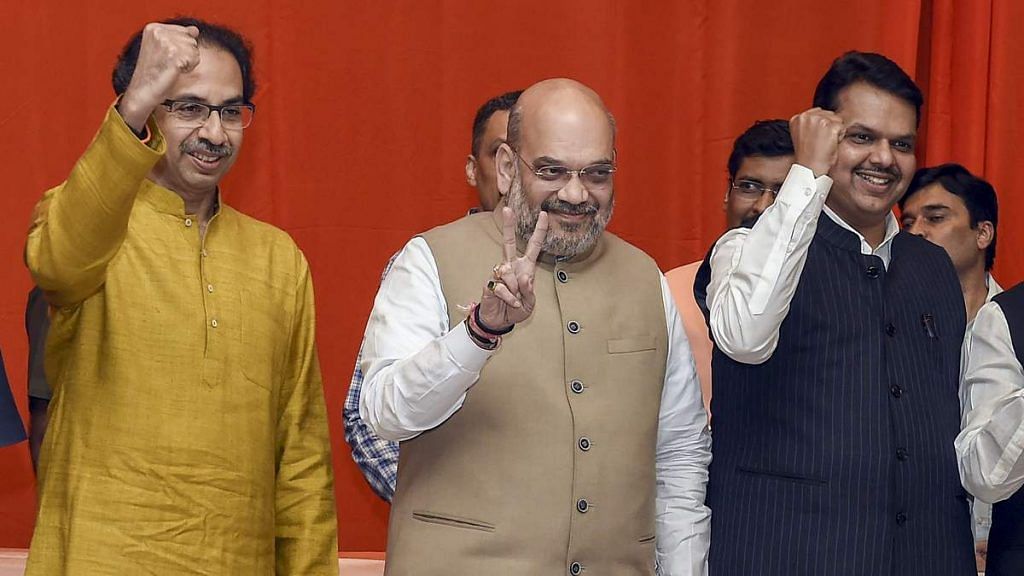Fresh from a historic victory in 2014, Amit Shah-led Bharatiya Janata Party refused to give into the Shiv Sena’s blackmail ahead of the Maharashtra assembly elections. The Shiv Sena, an ally of 25 years, had demanded an upper hand in pre-poll seat-sharing. The BJP didn’t relent.
After the elections threw up a hung assembly, the Shiv Sena had no choice but to support the Devendra Fadnavis government. After all, right-wing Shiv Sena can’t go with the Congress or the Nationalist Congress Party. Over the next five years, the Shiv Sena was a bickering partner, and often appeared to be the real opposition party.
Come 2019 and the Shiv Sena has accepted the reality that’s been staring the party in the face since 2009 when the BJP won more seats than it did: the BJP is a bigger player than the Sena in Maharashtra. The Shiv Sena has finally accepted the junior partner status.
All of this makes sense from the Shiv Sena’s perspective. But why did the BJP have to do an alliance with the Shiv Sena after winning 303 seats nationally? When the BJP was able to form government in Maharashtra without a pre-poll alliance in 2014, then 2019 would have been even easier. This was the election when the BJP could really have finished the Shiv Sena.
Yet, it chose not to do so. In fact, it doesn’t even dump smaller parties like Ramdas Athawale’s Republican Party of India (A) in Maharashtra.
Also read: BJP has detached politics from economics. That’s why it will win Haryana, Maharashtra
Who needs Nitish Kumar?
Meanwhile in another corner of the country, there have been rumblings that Nitish Kumar’s time is up. But Amit Shah has put the rumour mills to rest and declared that the alliance will continue under the leadership of Nitish Kumar.
The BJP is on such a high that it doesn’t have to suffer Nitish Kumar as Bihar’s chief minister. Since Nitish Kumar cannot go back to the Congress or the Rashtriya Janata Dal (RJD), the BJP can withdraw support from the JD(U)-led government, have fresh elections, and install a BJP chief minister in Bihar for the first time. It’s the sort of thing we’d expect the BJP of Modi-Shah to do.
Before the Lok Sabha elections, the BJP surprisingly conceded some of its seats to the JD(U) in Bihar, agreeing to contest on 17 seats each, thereby making the JD(U) an equal partner. That was the time for the JD(U) to blackmail the BJP, which was feeling the heat of farm distress and unemployment. But now, it is the right time for the BJP to strike and make the JD(U) redundant. One would especially expect the BJP to do so since Modi-Shah haven’t always had the best relations with Nitish Kumar. Similarly, one would expect the BJP to try and finish off the Shiv Sena in Maharashtra.
The way the BJP went about installing governments in Manipur, Goa, Karnataka and elsewhere, we’d expect the BJP to use the present moment to get rid of two pesky allies, the Shiv Sena and the JD(U).
Also read: BJP’s sleight of hand in Maharashtra and Haryana has gone unnoticed
Conception of power
That the BJP chooses to suffer pesky allies even at the peak of Modi’s popularity says a lot about Modi-Shah’s conception of power. They don’t want to, even mistakenly, create an opposition. Anyone who matters even a bit must be accommodated within the BJP fold, ideally as a submissive junior ally.
If the BJP were to get rid of Nitish Kumar, it would create an opposition in the state. This may not matter much for the BJP within Bihar, but it matters nationally and in the long run. The RJD has already been neutralised through the CBI and the ED, and the Congress is comatose-as-ever Congress. So, why create an opposition?
Similarly, in Maharashtra, the BJP has already eaten into the Nationalist Congress Party’s votes, and Congress is not even pretending that it’s fighting an election. Getting rid of the Shiv Sena may be feasible, but for the BJP of Modi-Shah, it is not desirable.
Modi-Shah want to rule with complete consent. Any opposition, even if it’s a leader who can stand up and be heard, is a problem. This is also why even the pro-India political leadership in Kashmir, which also participates in the elections, is under house arrest.
Thinking long-term
This conception of power reveals another facet of the Modi-Shah style of politics: they think long-term. What may be prudent now may not be prudent in the long run, and they always think long run. Nitish Kumar and Shiv Sena are as good as neutralised under the NDA umbrella, so why create problems?
When the Telugu Desam Party (TDP) in Andhra Pradesh quit the NDA in 2018, the BJP did not panic. It instead entered into a tacit understanding with the TDP’s rival, Jagan Mohan Reddy-led YSR Congress Party. It didn’t give up on Andhra, instead worked to help defeat the TDP badly. That’s not all, it now wants the TDP to merge with the BJP. Such moves show how the BJP thinks in terms of future elections.
This is in contrast to the Congress, which did not seriously consider the option of forming an alliance with the Aam Aadmi Party in Delhi in the 2019 Lok Sabha elections. It was unable to go across India and stitch a grand alliance. The Congress wants to kill regional threats directly, the BJP wants to kill them with kindness.
Also read: BJP has risen in Maharashtra by dismantling Sharad Pawar’s old empire piece by piece
Views are personal.
